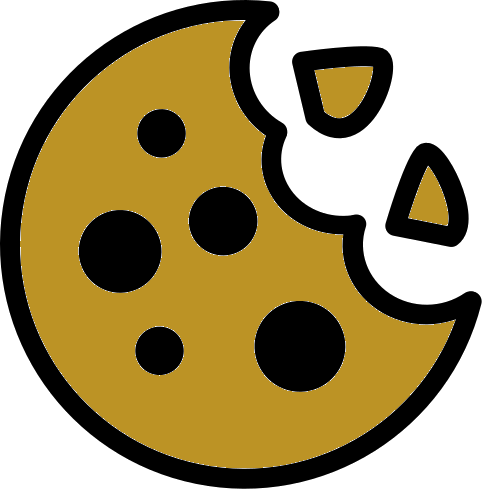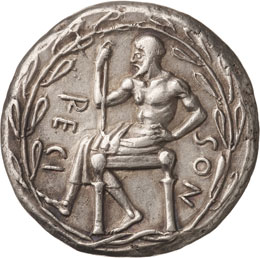- Home
- Masterpieces of Greek coinage
- 4 Italy. Bruttium, Rhegium. Tetradrachm, c. 450 - 445 BC. ...
Lotto 4 - Masterpieces of Greek coinage
Offerte
Descrizione
Tetradrachm, c. 450 - 445 BC. (Silver, 17.35g., 25.6mm). Lion’s mask facing; border of dots / RECI – NOS Iokastos, bearded and nude to the waist, seated left on a stool, holding a scepter in his right hand and resting his left on his hip; all within a laurel wreath. C.C. 34 (same dies). Herzfelder 1 (D1/R1, same dies). HN III 2477. Jameson 452 (same dies).
Grading/Stato: A masterpiece of Greek Art. Very rare, the finest specimen of this type known; the first of the ‘oikist’ tetradrachms of Rhegium, and the prototype for the series. A coin of splendid early classical style. Good extremely fine.
Provenance:
Numismatica Ars Classica 48, 21 October 2008, 19.
Numismatic Fine Arts XXII, 1 June 1989, 182.
Utilizzare il modulo di registrazione oppure effettuare il login cliccando sul link login in alto a destra.
Per qualsiasi informazione contattare auction@ngsa.ch
Masterpieces of Greek coinage
Orari
Offerte pre-asta - Fine
14 12 2015 10:00 CET
14 12 2015 09:00 Africa/Abidjan
Asta di sala - Inizio
14 12 2015 15:00 CET
14 12 2015 14:00 Africa/Abidjan
Contatti
Rond-point de Plainpalais 1, Ginevra, Genève, Svizzera
 Il rispetto della tua riservatezza è la nostra priorità
Il rispetto della tua riservatezza è la nostra priorità
Questo sito fa uso di cookie per migliorare l’esperienza di navigazione degli utenti e per raccogliere informazioni sull’utilizzo del sito stesso. Puoi consultare la nostra cookie policy, accettare tutti i cookie e proseguire nella navigazione cliccando su "Accetta" oppure personalizzare la tua scelta cliccando su "Personalizza".
Cookie Policy
Cookies
Per far funzionare bene questo sito, a volte installiamo sul tuo dispositivo dei piccoli file di dati che si chiamano "cookies". Anche la maggior parte dei grandi siti fanno lo stesso.
Cosa sono i cookies?
Un cookie è un piccolo file di testo che i siti salvano sul tuo computer o dispositivo mobile mentre li visiti. Grazie ai cookies il sito ricorda le tue azioni e preferenze (per esempio login, lingua, dimensioni dei caratteri e altre impostazioni di visualizzazione) in modo che tu non debba reinserirle quando torni sul sito o navighi da una pagina all'altra.
Come utilizziamo i cookies?
Cookie di terze parti
Google Analytics
Questo sito utilizza Google Analytics per raccogliere informazioni circa l'utilizzo degli utenti del proprio sito web. Google Analytics genera informazioni statistiche e di altro genere attraverso i cookie, memorizzati sui computer degli utenti. Le informazioni generate relative al nostro sito web sono utilizzate per fare dei report sull’utilizzo dei siti web. Google memorizzerà ed utilizzerà queste informazioni. La politica sulla privacy di Google è disponibile al seguente indirizzo: https://policies.google.com/privacy.
Non è necessario abilitare i cookies perché il sito funzioni, ma farlo migliora la navigazione. È possibile cancellare o bloccare i cookies, però in questo caso alcune funzioni del sito potrebbero non funzionare correttamente.
Le informazioni riguardanti i cookies non sono utilizzate per identificare gli utenti e i dati di navigazione restano sempre sotto il nostro controllo. Questi cookies servono esclusivamente per i fini qui descritti.
Come controllare e modificare i cookies?
In qualsiasi momento è possibile modificare o revocare il proprio consenso dalla dichiarazione dei cookie sul nostro sito Web.
Informativa sulla privacy
Scopra di più su chi siamo, come può contattarci e come trattiamo i dati personali nella nostra informativa sulla privacy.
I cookie necessari contribuiscono a rendere fruibile il sito web abilitandone funzionalità di base quali la navigazione sulle pagine e l'accesso alle aree protette del sito. Il sito web non è in grado di funzionare correttamente senza questi cookie.
| Nome | Fornitore | Scopo | Scadenza |
|---|---|---|---|
| cookieConsent | Bid Inside | Memorizza lo stato del consenso ai cookie dell'utente per il dominio corrente | 6 mesi |
| PHPSESSID | Bid Inside | Preserva gli stati dell'utente nelle diverse pagine del sito. | Quando termina la sessione di navigazione |
| f_display | Bid Inside | I cookie f_display memorizzano la modalità di visualizzazione scelta dall'utente nelle pagine in cui sono presenti delle liste | Quando termina la sessione di navigazione |
| f_page | Bid Inside | I cookie f_page memorizzano la pagina visualizzata dall'utente nelle pagine in cui sono presenti delle liste | Quando termina la sessione di navigazione |
| f_rec_page | Bid Inside | I cookie f_rec_page memorizzano il numero di elementi da visualizzare per pagina scelto dall'utente nelle pagine in cui sono presenti delle liste | Quando termina la sessione di navigazione |
| f_order_by | Bid Inside | I cookie f_order_by memorizzano il parametro di ordinamento selezionato dall'utente nelle pagine in cui sono presenti delle liste | Quando termina la sessione di navigazione |
| f_order_dir | Bid Inside | I cookie f_order_dir memorizzano la direzione di ordinamento scelta dall'utente nelle pagine in cui sono presenti delle liste | Quando termina la sessione di navigazione |
| watch_list_show_imgs | Bid Inside | Il cookie watch_list_show_imgs memorizza la scelta dell'utente riguardo il mostrare o il nascondere le immagini dei lotti nella pagina con la lista dei lotti in osservazione | Quando termina la sessione di navigazione |
| selected_voice | Bid Inside | Il cookie selected_voice memorizza la voce selezionata dall'utente per la sintesi vocale presente nell'asta live | 1 Mese |
| include_autobids | Bid Inside | Il cookie include_autobids memorizza la scelta dell'utente di mostrare o nascondere le proprie auto-bid nella pagina 'Le tue offerte' | 6 mesi |
I cookie analitici aiutano a capire come i visitatori interagiscono con il sito web, raccogliendo e trasmettendo informazioni statistiche al Titolare del trattamento.
| Nome | Fornitore | Scopo | Scadenza |
|---|---|---|---|
| _ga | Registra un ID univoco utilizzato per generare dati statistici su come il visitatore utilizza il sito internet. | 2 anni | |
| _gat_gtag | Utilizzato da Google Analytics per limitare la frequenza delle richieste | 1 giorno | |
| _gat | Utilizzato da Google Analytics per limitare la frequenza delle richieste | 1 giorno | |
| _gid | Registra un ID univoco utilizzato per generare dati statistici su come il visitatore utilizza il sito internet. | 1 giorno | |
| __utma | Bid Inside | Utilizzato per distinguere utenti e sessioni. Il cookie viene creato quando viene eseguita la libreria javascript e non esistono cookie __utma esistenti. Il cookie viene aggiornato ogni volta che i dati vengono inviati a Google Analytics. | 2 anni |
| __utmt | Bid Inside | Utilizzato per limitare la velocità di richiesta. | 10 minuti |
| __utmb | Bid Inside | Utilizzato per determinare nuove sessioni/visite. Il cookie viene creato quando viene eseguita la libreria javascript e non esistono cookie __utmb esistenti. Il cookie viene aggiornato ogni volta che i dati vengono inviati a Google Analytics. | 30 minuti |
| __utmc | Bid Inside | Non utilizzato in ga.js. Impostato per l'interoperabilità con urchin.js. Storicamente, questo cookie operava insieme al cookie __utmb per determinare se l'utente si trovava in una nuova sessione/visita. | Quando termina la sessione di navigazione |
| __utmz | Bid Inside | Memorizza la sorgente di traffico o la campagna che spiega come l'utente ha raggiunto il tuo sito. Il cookie viene creato quando viene eseguita la libreria javascript e viene aggiornato ogni volta che i dati vengono inviati a Google Analytics. | 6 mesi |
| __utmv | Bid Inside | Utilizzato per memorizzare dati variabili personalizzati a livello di visitatore. Questo cookie viene creato quando uno sviluppatore utilizza il metodo _setCustomVar con una variabile personalizzata a livello di visitatore. Questo cookie è stato utilizzato anche per il metodo _setVar deprecato. Il cookie viene aggiornato ogni volta che i dati vengono inviati a Google Analytics. | 2 anni |
I cookie di preferenza/tecnici consentono a un sito web di ricordare le informazioni che influenzano il modo in cui il sito si comporta o si presenta, come la lingua preferita o la regione che ti trovi.
Non usiamo cookie di questo tipo.I cookie di profilazione vengono utilizzati per finalità di marketing, per monitorare i visitatori del sito web. L'intento è quello di visualizzare annunci pertinenti e coinvolgenti per il singolo utente.
Non usiamo cookie di questo tipo.I cookie non classificati sono i cookie che sono in fase di classificazione, insieme ai fornitori di cookie individuali.
Non usiamo cookie di questo tipo.





 5
5